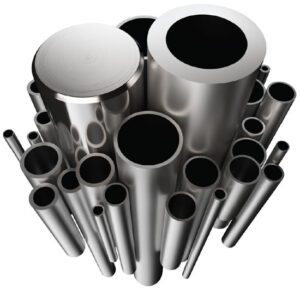Traditionally, the challenge for steel manufacturers has been to produce materials for LNG applications that can solve a dual problem. These have to be highly resistant against corrosion, possess superior mechanical strength, and a good weldability. Secondly, they need to offer world-class machinability to extend tool life or enable a speedy production of components.
A new and growing breed of stainless steels is addressing both of these challenges.
By Magnus Brink
Global economic pick up following various waves of the pandemic and geopolitical issues mean energy markets are tightening and the demand for LNG is increasing. This has created a growing need for LNG components. Original equipment manufacturers (OEMs) and fabricators require optimized stainless steel grades to help reduce order backlogs, boost productivity, and allow faster turnarounds. These market requirements have implications for the materials used and their properties such as machinability.
This is the ease with which a metal can be cut, permitting the removal of material with a satisfactory finish at a low(er) cost. This can be hard to predict due to wide-ranging variables, such as the condition of the work material or physical properties. The type of CNC (computer numerical control) machine being used, cutting tool materials and geometries, speeds, temperatures, lubricants, and other factors also require consideration. As a result, machinability gains are often evaluated on a case-by-case basis, depending on a specific manufacturing process.
Physical and mechanical considerations
In addition, even within industry standards, the condition of the core material can vary significantly. There are eight key factors to consider when it comes to the physical properties of materials:
1. Microstructure – ensuring it is even throughout the material.
2. Grain size – should be fine and even.
3. Heat treatment – controlled and short time to quench.
4. Chemical composition – kept tight to ensure repeatability from batch to batch
5. Fabrication – qualified and audited by third parties.
6. Hardness – in line with NACE requirements.
7. Impact strength – sufficient to cope with higher demands for critical components.
8. Tensile strength – high ductility to meet end-user demands.
On top of this, and relating to individual material groups, the following mechanical factors need to be considered:
• Modulus of elasticity
• Thermal conductivity
• Thermal expansion
• Work hardening
Challenging to machine
 Several of these factors, such as work hardening, are of particular concern when considering high alloy stainless steels. This is because stainless steels are generally more challenging to machine, compared to regular carbon steels, as they are often tougher, gummier, and tend to work harden very rapidly.
Several of these factors, such as work hardening, are of particular concern when considering high alloy stainless steels. This is because stainless steels are generally more challenging to machine, compared to regular carbon steels, as they are often tougher, gummier, and tend to work harden very rapidly.
Work hardening is where the surface of the material strengthens as it is being machined. This makes it progressively harder to machine and dulls cutting tools faster.
Such machining challenges are closely related to the presence of higher nickel content and other tough alloying elements which are the very elements that make these high-alloy steels so attractive for challenging corrosive, high-stress applications in the LNG industry.
An age-old quest
The quest to make stainless steel more machinable and weldable has been going on for many years. In the mid 20th century, metallurgists discovered that adding small amounts of sulphur to the chemical composition had the effect of forming a lubrication layer on top of the cutting tool, reducing friction, and extending tool life. The impact was so favorable that many specialty steelmakers started adding sulphur or phosphorous to grades like 303, 416, and 420.
However, while sulphur and phosphorous have certain advantages, they also adversely impact many of the positive properties of stainless steel. For example, sulphur lowers the mechanical and corrosion properties and affects the microstructure in such a way that leads to brittleness during welding.
Metallurgical dilemma
The metallurgical dilemma of how to produce stainless steels with high corrosion resistance, superior mechanical strength, and good weldability, while also offering world-class machinability existed for many years in the second half of the 20th century. However, metallurgists at a leading global materials technology company found that by adding non-metallic inclusions to materials they could manipulate the grain boundaries in the microstructure to replace the high sulphur content and facilitate chip formation at a lower yield strength. This resulted in a material that had all the corrosion mitigation advantages of standard stainless steels but with high machinability.
The applications for machinability-improved stainless steel bar and hollow bar include valves and actuators such as flow meters, valves, strainers, baskets,
and samplers. They can also be used in pumps and compressors, for example, vacuum equipment, hydraulic cylinders, pump housings, and compression bodies.
They can also be deployed in a wider range of onshore and offshore applications for the LNG industry such as onshore liquefaction, regasification and storage facilities, FPSO (floating production, storage and offloading) vessels and FRSUs (floating storage regasification units).
Avoiding intergranular corrosion
The benefits of improved materials are not confined to better machinability. For example, they are helping solve the long-standing challenge of intergranular corrosion (IGC) due to welding.
The microstructure of metals and alloys consists of grains separated by boundaries. IGC is a selective attack near these grain boundaries. Usually associated with chemical segregation, it’s caused by chromium depletion, mainly due to the precipitation of chromium carbides in the grain boundaries. Chromium carbides can be precipitated if the stainless steel is sensitized in the temperature range 550–850°C (1020–1560°F), for example during welding. If the material is exposed to this critical temperature range for too long, chromium carbides start to form in the grain boundaries. These become susceptible to
IGC, creating a potentially serious impact on the material’s mechanical properties.
Reduced carbon content Materials with less than 0.05% carbon normally have sufficient resistance against IGC after welding. Extra-low carbon content steels with maximum 0.030% carbon have very good resistance
to IGC. This is also true for steels stabilized with titanium (Ti) or niobium (Nb). These types of steel form niobium or titanium carbides instead of chromium carbides. This avoids the critical decrease in the chromium content.
A recently launched example of a material developed to combat chromium carbide precipitation and IGC is Sanicro® 825 from Sandvik Materials Technology. The grade is a titanium-stabilized nickel-iron-chromium alloy with an extra-low carbon content. Available in bar and hollow bar and containing more than 40% nickel, it has excellent corrosion resistance and good machinability and was designed to avoid the risk of intermetallic phases during welding at higher temperatures, even in the heaviest sizes.
A growing trend
 To conclude, corrosion mitigation will always be a key consideration for LNG applications. The development of stainless steels to optimize machining properties and improve welding capabilities will continue. However, the addition of inclusions opens up the potential to improve the properties and capabilities of an even broader range of steel types – from austenitic stainless steels to duplex and higher alloys. This will enable OEMs to achieve higher productivity and longer tool life to support LNG’s growth.
To conclude, corrosion mitigation will always be a key consideration for LNG applications. The development of stainless steels to optimize machining properties and improve welding capabilities will continue. However, the addition of inclusions opens up the potential to improve the properties and capabilities of an even broader range of steel types – from austenitic stainless steels to duplex and higher alloys. This will enable OEMs to achieve higher productivity and longer tool life to support LNG’s growth.
About this Featured Story
This Featured Story appeared in Stainless Steel World December 2022 magazine. To read many more articles like these on an (almost) monthly basis, subscribe to our magazine (available in print and digital format) – SUBSCRIPTIONS TO OUR DIGITAL VERSION ARE NOW FREE.
Every week we share a new Featured Story with our Stainless Steel community. Join us and let’s share your Featured Story on Stainless Steel World online and in print.


